When it comes to painting walls and ceilings, one of the most common challenges homeowners and professionals face is hiding imperfections. Whether it’s a textured wall, uneven surface, or minor damage, the right tool can make all the difference. That’s where finding the Best Paint Roller to Hide Imperfections becomes essential. The right roller helps you achieve a surface that looks polished, even, and professional—without the need for excessive prep work or multiple coats.
In this guide, we’ll explore which paint rollers are best for hiding imperfections, the different types of rollers available, and expert tips on how to use them effectively to achieve a smooth and flawless finish.
Contents
Why the Right Paint Roller Matters
A high-quality paint roller plays a crucial role in ensuring your paint job looks smooth and even. The texture of the roller cover, the length of the nap (the fibers), and the material all contribute to how well it can hide imperfections like dents, cracks, bumps, and brush strokes. The right roller can help you achieve better coverage with fewer coats of paint and a more uniform finish.
Using the wrong type of roller, on the other hand, can accentuate flaws, making them more visible and giving your walls a less-than-perfect appearance.
Factors to Consider When Choosing the Best Roller for Imperfections
To effectively hide imperfections, you need to choose a paint roller that complements the surface you’re painting and the type of imperfections you want to cover. Here are the key factors to keep in mind:
1. Nap Length
The nap length refers to the length of the fibers on the roller cover. The length of the nap affects the texture you can achieve and how well the roller will fill in cracks and cover imperfections.
- Short Nap (1/4” – 3/8”): Best for smooth surfaces. If you have a perfectly smooth wall with minimal imperfections, a short nap roller provides an even, smooth finish.
- Medium Nap (1/2” – 3/4”): Ideal for lightly textured surfaces. It’s great for walls with minor imperfections, like small cracks or divots.
- Long Nap (1” – 1 1/4”): Perfect for rough or heavily textured surfaces. It’s ideal for filling in larger gaps, cracks, and rough textures, and can help hide imperfections more effectively.
For hiding imperfections, medium to long nap rollers are typically the best options. They have more texture and can help spread paint over imperfections, making the surface appear smoother.
2. Material of the Roller Cover
The material of the roller cover can affect the finish and smoothness of your paint job. The most common materials are:
- Microfiber: Microfiber roller covers are popular for their ability to provide smooth, even coverage. They hold a lot of paint and can help hide imperfections like bumps and scratches.
- Lambswool: Lambswool rollers are known for producing a very smooth, professional finish. These rollers are particularly good for hiding imperfections on textured walls, as they apply paint evenly and fill gaps without leaving streaks.
- Synthetic (Nylon or Polyester): Synthetic rollers are durable and can be used with all types of paints. They provide a consistent finish and are great for hiding imperfections on less-textured surfaces.
For hiding imperfections, microfiber and lambswool rollers are the top choices due to their ability to apply paint evenly and fill in surface irregularities.
3. Roller Size
The size of the roller refers to its width. A wider roller will cover more surface area quickly, while a smaller roller allows for greater control, especially in tight spaces or areas with heavy imperfections.
- 9-inch roller: The most common size for general painting. It’s versatile and works well for large areas.
- 4-inch roller: Ideal for trim, corners, and smaller areas where you need more precision.
For covering imperfections on standard walls, a 9-inch roller will typically provide the best coverage without leaving uneven streaks.
Best Paint Roller to Hide Imperfections
Let’s take a look at some of the best paint rollers available that can help you hide imperfections effectively:
1. Purdy White Dove Roller Cover
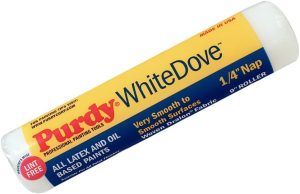
Best For: General use on smooth to moderately textured walls.
Purdy is a well-known brand in the painting industry, and their White Dove roller covers are a favorite for achieving a smooth finish while hiding imperfections. These rollers have a medium nap (3/8” or 1/2”), which makes them great for lightly textured walls or those with minor imperfections.
- Nap Length: 3/8” – 1/2”
- Material: Microfiber
- Best For: Even coverage, smoothing minor imperfections, and providing a uniform finish.
Why it’s great for imperfections: The microfiber material picks up and evenly distributes paint, helping to fill in any tiny cracks or holes and providing a professional, smooth finish.
2. Wooster Pro/Doo-Z Roller Cover
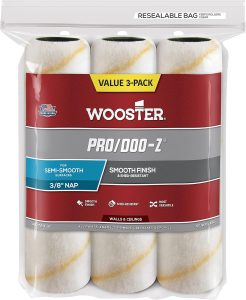
Best For: Textured surfaces and uneven walls.
The Wooster Pro/Doo-Z roller cover is known for its ability to handle rougher surfaces and hide imperfections effectively. It’s available in a variety of nap lengths, but the 3/4-inch nap is particularly effective for filling in dents and uneven areas while applying a thick, even layer of paint.
- Nap Length: 3/4”
- Material: Microfiber blend
- Best For: Textured walls, covering bumps and uneven surfaces.
Why it’s great for imperfections: The 3/4-inch nap helps fill in gaps, cracks, and surface blemishes, leaving you with a smooth, even finish even on rougher surfaces.
3. Sherwin-Williams Premium Roller Cover
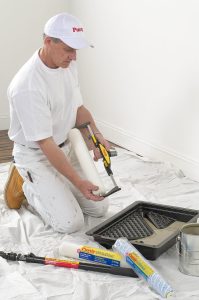
Best For: Smoothing out uneven surfaces and hiding imperfections in paint jobs.
Sherwin-Williams Premium Roller Covers are designed to help achieve a professional-looking finish. They feature a medium to thick nap, which is perfect for hiding imperfections on moderately textured surfaces. They also have a high-capacity design, allowing you to hold more paint and apply it more evenly.
- Nap Length: 3/8” – 1/2”
- Material: Synthetic fibers
- Best For: Smooth to lightly textured surfaces and minor imperfections.
Why it’s great for imperfections: These roller covers are excellent at providing a smooth finish with minimal roller marks, and the synthetic fibers make them perfect for evenly applying paint to surfaces with minor flaws.
4. Benjamin Moore Super-Fab Roller Cover
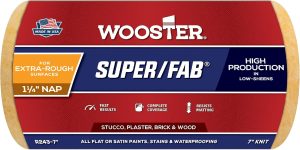
Best For: Hiding minor to moderate imperfections and achieving a professional-quality finish.
Benjamin Moore’s Super-Fab roller covers are known for their durability and excellent finish. These rollers are designed to handle both smooth and lightly textured surfaces, making them great for hiding imperfections while delivering a flawless, smooth result.
- Nap Length: 3/8” – 1/2”
- Material: Microfiber blend
- Best For: General-purpose painting and smoothing out imperfections.
Why it’s great for imperfections: The microfiber construction holds a lot of paint and applies it smoothly, helping to reduce roller marks and fill in surface irregularities.
5. Purdy Monarch Elite Roller Cover
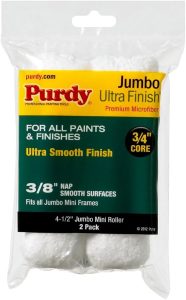
Best For: Textured walls and surfaces with visible flaws.
Purdy Monarch Elite roller covers are designed for durability and uniform coverage. These rollers come with a medium nap, making them perfect for textured walls, where you need the roller to reach into the grooves and fill in imperfections.
- Nap Length: 1/2” – 3/4”
- Material: Polyester
- Best For: Covering imperfections on textured walls and surfaces.
Why it’s great for imperfections: The roller’s medium nap and high-quality construction provide excellent coverage and smooth out textured surfaces, concealing minor flaws and giving you a flawless finish.
Tips for Using Best Paint Roller to Hide Imperfections
Now that you’ve chosen the right paint roller for your needs, here are a few tips to ensure that you effectively hide imperfections:
- Use a Primer: Priming the wall before painting is crucial, especially if you’re working with damaged or textured surfaces. A primer creates a uniform base that helps paint adhere better and hide imperfections.
- Use a “W” Motion: When applying the paint, use a “W” or “M” motion, which helps evenly distribute the paint and prevents roller marks. Don’t press too hard—let the roller do the work to avoid pushing paint into the imperfections.
- Multiple Coats: Sometimes, one coat of paint isn’t enough to fully cover imperfections. Apply a second coat after the first one dries to ensure full coverage and a more polished finish.
- Don’t Overload the Roller: Overloading the roller with too much paint can lead to streaks and uneven coverage. Make sure to load the roller with just enough paint to cover an area without excess drips.
- Smooth Out Roller Marks: After applying the paint, roll over the surface with a dry roller to smooth out any roller marks and create an even texture.
Conclusion
The best paint roller to hide imperfections is one that offers excellent coverage, a good nap length, and the ability to handle your specific surface texture. Medium to long nap rollers made of microfiber or lambswool are typically the best choices for achieving a smooth, even finish while filling in cracks, bumps, and other imperfections.
By selecting the right roller and applying the paint with care, you can achieve a professional-quality finish that makes imperfections disappear, leaving your walls looking flawless.


Leave a Reply